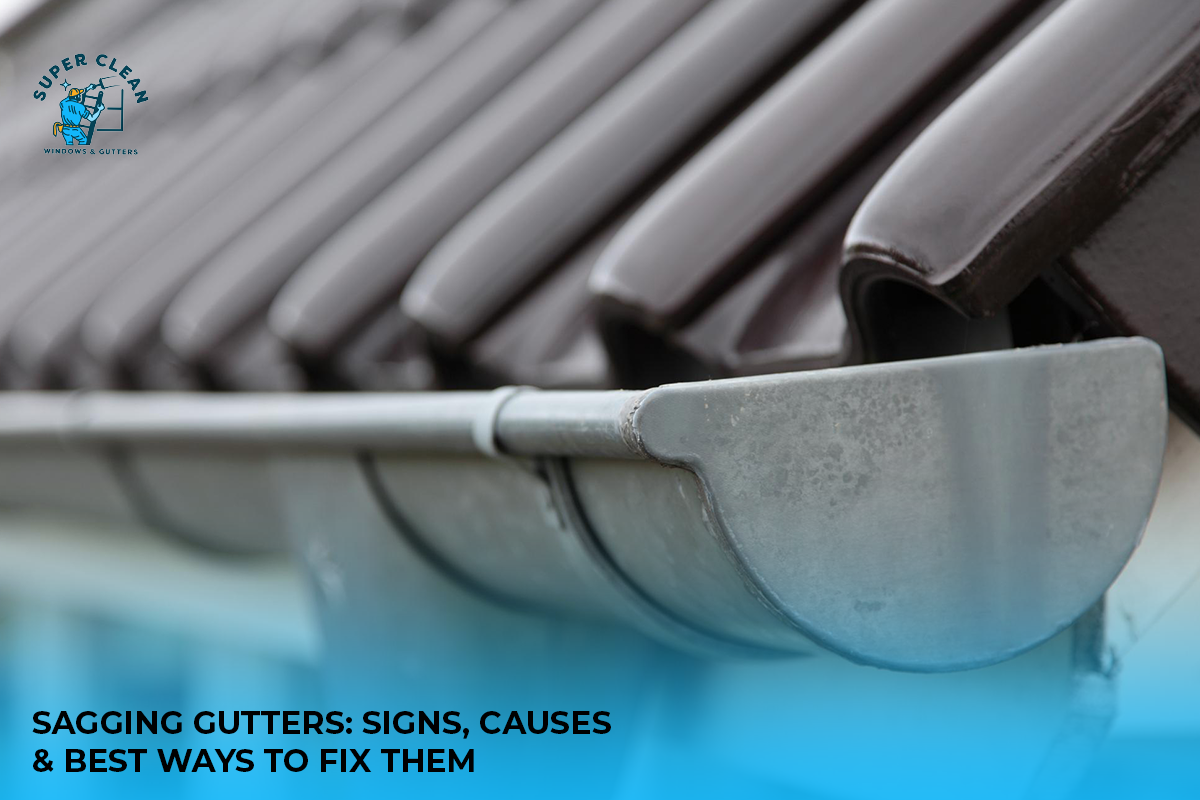Sagging Gutters: Signs, Causes & Best Ways to Fix Them
Ever walked outside after a storm and noticed a waterfall pouring off your roofline? That might look dramatic, but it’s often a clue to something worse happening above. A couple in Kentucky ignored it too long, and water damage turned into thousands in repairs. Situations like this remind us how sagging gutters silently weaken the strength of any home’s structure. It’s avoidable, though, and you just need to act before the problem grows.
Spot the Early Warning Signs Before It Gets Expensive
At first glance, a slight dip in your gutter might not seem like much trouble. Then, heavy rain hits, and water floods your garden, spilling onto your siding and pools below. These are the classic signs of sagging gutters that demand urgent attention before they escalate. When gutters pull away or show open spaces at the edges, it signals bigger underlying problems.
Let’s get real for a moment.
If your gutters tilt, twist, or trap water, they’re already under too much strain. Every homeowner should know these signs of sagging gutters and act early to avoid destruction.
Why Gutters Sag: The Real Story Behind the Damage
Big storms are not the only things that can damage your entire gutter system. One of the leading causes of sagging gutters is excess debris, such as leaves and mud, piling up. These clogged gutters slowly drag down the structure until they start pulling from your home.
Combine that with aging brackets or improper installations, and you'll face real trouble. In some cases, snow and ice create an expansion that leads to broken or warped metal. This kind of stress highlights how the causes of sagging gutters are easy to miss but tough to ignore.
The Fixes You Need That Won’t Break Your Bank
If you're unsure about how to fix sagging gutters, begin by cleaning out every inch of debris. Use a level to confirm the slope ensures water moves to the downspouts without delay.
Once clean, check every bracket and screw for damage and replace them where needed. Strong hangers will restore firm gutter support and reduce future strain during rainfall. Most folks who try fixing gutters this way experience immediate improvement and fewer issues in the long term.
Gutter Maintenance: A Small Habit With Big Results
You do not have to be an expert to maintain your home’s gutter system properly. Smart gutter maintenance involves checking seasonally and looking for sagging sections or small leaks.
Neglect leads to the most common issues that homeowners later regret not handling early enough. Ignoring routine maintenance leads to common gutter problems, like leaks and sagging. Just thirty minutes with gloves, a scoop, and running water can keep your system flowing well. Ignore it now, and your next repair could cost hundreds of dollars in replacement or interior work.
Experts Share the Best Gutter Repair Practices
Homeowners trying to avoid replacement should hire a professional to carry out essential gutter repairs. These pros look at the slope, test the water flow, and secure every fastener correctly.
In wetter regions, specialists recommend seamless gutter systems for durability and better performance. These help prevent damaged gutters from failing year after year during heavy seasonal weather. Good materials and skilled labor go a long way when protecting your home’s structure.
Stop Gutter Sagging Before It Starts: Real Prevention That Works
Prevention is always better than waiting for a storm to reveal weak points in your setup. Try installing guards to keep debris out and confirm your slope supports drainage all year long.
Another way to prevent sagging gutters is by spacing hangers evenly and replacing weak ones. If these adjustments are made now, your roof and siding will remain dry through every season.
What Happens If You Ignore The Problem?
Homeowners who delay maintenance often end up replacing parts of their homes unnecessarily. The impact of damaged gutters ranges from moldy walls to cracked foundations in extreme conditions.
In one state, a homeowner lost garden space due to flooding caused by blocked and sagging metal. Fixing minor problems today stops major costs from creeping in quietly tomorrow.
Gutter Solutions That Last: When It’s Time for a Full Reset
If you’ve repaired your gutters more than twice, you might consider complete gutter replacement instead. Newer systems can handle heavy rain, resist rust, and last much longer with very little effort.
Professionals recommend investing in seamless designs that ensure smooth water flow and reduced leaks. Homeowners who switch often find they need fewer cleanings and avoid constant gutter solutions.
Quick Wins: Small Things That Save You
You can reduce long-term damage by doing small tasks throughout the year with minimal time. Schedule seasonal cleanings, take photos of suspicious bends, and replace faulty pieces right away.
Installing guards is one way to keep your system clean and prevent sagging gutters before storms arrive. These easy actions create lasting peace of mind and limit emergency repairs.
Time to Act: Don’t Wait for Water to Spread
Stop waiting for another storm to show where your gutters are already falling behind. Take a moment to walk your property and note anything that leaks or looks unstable.
Call a trusted local expert if you spot signs of wear that need urgent attention. Every step you take today reduces the risk of spending more when water causes interior damage.
Keep Your Gutters Working Without Fail
Secure your investment by ensuring your gutters are strong, clear, and properly supported. Clean them regularly or call a qualified technician for trusted evaluation and fast, dependable repair. A few hours of attention can protect your entire home from the worst weather ahead.
Conclusion
Now you understand the warning signs, hidden causes, and best ways to repair sagging systems. From gutter repair to prevention, this guide was built to prepare you for every challenge. Take control of your home’s future now, starting with clean, supported, and long-lasting gutters.

